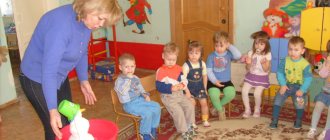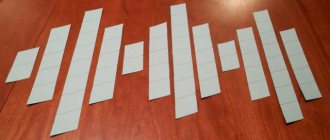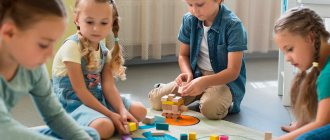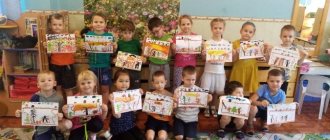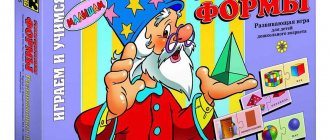Library "Programs of education and training in kindergarten"
Generally edited by:
Doctor of Pedagogical Sciences T. S. Komarova, Candidate of Pedagogical Sciences V. V. Gerbova.
The program for the education and training of children of the second younger group is printed with corrections and additions according to the text of the book “The program for education and training in kindergarten” edited by M. A. Vasilyeva, V. V. Gerbova, T. S. Komarova (4th ed. , corrections and additions).
Compiled by M. B. Zatsepina
Contributing authors
A. V. Antonova,
Doctor of Pedagogical Sciences;
N. A. Arapova-Piskareva;
N. E. Veraksa, Doctor of Psychological Sciences;
V. V. Gerbova,
candidate of pedagogical sciences;
N. F. Gubanova,
candidate of pedagogical sciences;
O. V. Dybina,
Doctor of Pedagogical Sciences;
M. B. Zatsepina,
Doctor of Pedagogical Sciences;
T. S. Komarova,
Doctor of Pedagogical Sciences;
G. M. Lyamina,
candidate of pedagogical sciences;
V. I. Petrova,
Doctor of Pedagogical Sciences;
O. A. Solomennikova,
candidate of pedagogical sciences;
E.Ya.
Stepanenkova, candidate of pedagogical sciences.
From the compiler
The effectiveness and quality of the pedagogical process depend on a number of factors, and primarily on whether upbringing and training is based on the age characteristics of children.
Pedagogical science, putting forward central educational and educational tasks for a certain period of childhood, recommends techniques and methods for their implementation, substantiates their correspondence to each year of a child’s life, in order to equip practitioners with effective professional means for the successful development of a group of children in a group and each pupil.
This manual, dedicated to the issues of education, training and development of children in the second junior group of kindergarten, is also based on the age principle.
One of the features of the psychological portrait of a child of the fourth year of life is the “three-year crisis.” Communicating with children experiencing a crisis is not easy, since the child’s intentions take on a stubbornly persistent “I want!” or the categorical “I won’t!” The crisis is generated by the fact that the child begins to perceive himself as an independent person, separate from others (and from his beloved adult), and he has the right to respect for himself and his intentions. Adults need to learn, without pressure or physical coercion, to reorient a “naughty” child to something else, to tell him how interesting it is to go somewhere (to see something, find something, etc.).
The source of development and expansion of children's horizons and ideas is direct observations (in kindergarten and beyond). The ability to observe and draw simple conclusions in a child of the fourth year of life becomes more perfect; the desire for active action and interest in means and methods of practical action as the basis for the development of manual skills increases.
A child of this age develops an interest in patterns and the opportunity to try to reproduce them.
Children are more successful in mastering a new way of activity if its goal is clear and the motivation for achieving it, accepted by the children, is created.
The fourth year of life is important for the further development of the child’s attitude towards himself. A general positive attitude towards oneself is expressed in satisfaction with one’s own achievements, approved by adults. But you should very gently and tactfully develop the ability to think critically about your actions and the results of your activities.
Memory processes at this age remain involuntary, but children successfully remember what they liked. The child's ability to control his attention is very small (it is especially difficult to direct attention to anything using words). Speech at this age remains situational and dialogical, but becomes more complex and developed. Objects and phenomena are perceived holistically, although some sensory attributes of objects begin to stand out as independent. And so on.
This methodological manual, which includes a program for working with children of the fourth year of life and the conditions, methods, techniques for implementing program tasks, will become for teachers (we really hope so!) a reference book designed to answer all emerging questions related to the specifics of work in second junior group of kindergarten.
Program
Age-related characteristics of children's mental development
At the age of 3–4 years, the child gradually leaves the family circle. His communication becomes non-situational.
An adult becomes for a child not only a family member, but also a bearer of a certain social function.
The child’s desire to perform the same function leads to a contradiction with his real capabilities. This contradiction is resolved through the development of play, which becomes the leading activity in preschool age.
The main feature of the game is its convention: performing certain actions with certain objects presupposes their attribution to other actions with other objects. The main content of the play of younger preschoolers is actions with toys and substitute objects. The game duration is short. Younger preschoolers are limited to playing with one or two roles and simple, undeveloped plots. Games with rules are just beginning to take shape at this age.
A child’s visual activity depends on his ideas about the subject.
At this age they are just beginning to form. Graphic images are poor. Some children's images lack detail, while others' drawings may be more detailed. Children can already use color.
Modeling is of great importance for the development of fine motor skills.
Younger preschoolers are able to sculpt simple objects under the guidance of an adult.
It is known that application has a positive effect on the development of perception. At this age, children have access to the simplest types of appliqué.
Constructive activity in early preschool age is limited to the construction of simple buildings according to a model and design.
In early preschool age, perceptual activity develops. Children move from using prestandards—individual units of perception—to sensory standards—culturally developed means of perception. By the end of primary preschool age, children can perceive up to five or more shapes of objects and up to seven or more colors, are able to differentiate objects by size, orient themselves in the space of a kindergarten group, and with a certain organization of the educational process, in the premises of the entire preschool institution.
Memory and attention develop. At the request of an adult, children can remember 3-4 words and 5-6 names of objects. By the end of primary preschool age, they are able to remember significant passages from their favorite works.
Visual and effective thinking continues to develop. At the same time, transformations of situations in some cases are carried out on the basis of targeted tests, taking into account the desired result. Preschoolers are able to establish some hidden connections and relationships between objects.
In early preschool age, imagination begins to develop, which is especially clearly manifested in play, when some objects act as substitutes for others.
The relationships between children are determined by norms and rules. As a result of targeted influence, they can learn a relatively large number of norms, which serve as the basis for evaluating their own actions and the actions of other children.
Children's relationships are clearly manifested in play activities. They rather play nearby than actively interact.
However, already at this age stable selective relationships can be observed.
Conflicts arise mainly over toys. The child's position in the peer group is largely determined by the opinion of the teacher.
In early preschool age, one can observe a subordination of motives for behavior in relatively simple situations. Conscious control of behavior is just beginning to emerge; In many ways, a child’s behavior is still situational.
At the same time, one can also observe cases of the child himself limiting his own motives, accompanied by verbal instructions. Self-esteem begins to develop, and children are largely guided by the teacher’s assessment. Their gender identification also continues to develop, which is manifested in the nature of the toys and stories they choose.
Work program for the teacher of the second junior group
Examination of illustrations for the Russian folk tale “Kolobok”. The sketch is a dramatization of “the bun is rolling along the path.”Complex classes. According to the program “From birth to school”, edited by
NOT. Veraxes,
T.S. Komarova, M.A. Vasilyeva, Art. 58
Sound culture of speech: the sound “o”
Complex classes. According to the program “From birth to school”, edited by
NOT. Veraksy, T.S. Komarova, M.A. Vasilyeva, Art. 63
Reading the Russian folk tale “The Three Bears.”
Complex classes. According to the program “From birth to school”, edited by
NOT. Veraxes,
T.S. Komarova, M.A. Vasilyeva, Art. 71
Sound culture of speech: the sound “and”.
Complex classes. According to the program “From birth to school”, edited by
NOT. Veraxes,
T.S. Komarova, M.A. Vasilyeva, Art. 77
Russian folk nursery rhymes - “Kitsonka-murysonka”, “The cat went to the market”, etc.
Complex classes. According to the program “From birth to school”, edited by
NOT. Veraxes,
T.S. Komarova, M.A. Vasilyeva, Art. 85
Fairy tale "Sister Alyonushka and brother Ivanushka."
Complex classes. According to the program “From birth to school”, edited by
NOT. Veraxes,
T.S. Komarova, M.A. Vasilyeva, 92
Reading a poem by S.Ya.Marshak from the series “Children in a Cage.”
Complex classes. According to the program “From birth to school”, edited by
NOT. Veraxes,
T.S. Komarova, M.A. Vasilyeva, Art. 99.
Sound culture of speech.
Complex classes. According to the program “From birth to school”, edited by
N. E. Veraksy,
T.S. Komarova,
M.A. Vasilyeva, Art. 110
Reading Russian folklore Fairy tales "Masha and the Bear".
Complex classes. According to the program “From birth to school”, edited by
N. E. Veraksy,
T.S. Komarova,
M.A. Vasilyeva, Art. 106
Sound culture of speech. Sounds "m" and "m'"
Complex classes. According to the program “From birth to school”, edited by
NOT. Veraxes,
T.S. Komarova,
M.A. Vasilyeva, art. 116.
Sound culture of speech: sounds [b], [d].
Complex classes. According to the program “From birth to school”, edited by
NOT. Veraxes,
T.S. Komarova,
M.A. Vasilyeva, Art. 122.
Reading the story “It’s snowing” by L. Voronkova.
Complex classes. According to the program “From birth to school”, edited by
NOT. Veraxes,
T.S. Komarova,
M.A. Vasilyeva, Art. 130.
Sound culture of speech.
Complex classes. According to the program “From birth to school”, edited by
NOT. Veraxes,
T.S. Komarova,
M.A. Vasilyeva, Art. 135
A conversation about the Russian folk tale “The Snow Maiden and the Fox.” Reading poetry.
Complex classes. According to the program “From birth to school”, edited by
NOT. Veraxes,
T.S. Komarova, M.A. Vasilyeva, St. 144.
Examination of illustrations for the fairy tale “Geese and Swans”.
Complex classes. According to the program “From birth to school”, edited by
NOT. Veraxes,
T.S. Komarova, M.A. Vasilyeva, art. 149.
Reading of Z. Alexandrova’s poem “My Teddy Bear”.
Complex classes. According to the program “From birth to school”, edited by
NOT. Veraxes,
T.S. Komarova,
M.A. Vasilyeva, Art. 157
Sound culture of speech: sound [t].
Complex classes. According to the program “From birth to school”, edited by
NOT. Veraxes,
T.S. Komarova,
M.A. Vasilyeva, Art. 162
Reading the Russian folk tale “The Wolf and the Seven Little Goats.”
Complex classes. According to the program “From birth to school”, edited by
NOT. Veraxes,
T.S. Komarova,
M.A. Vasilyeva, Art. 169
Sound culture of speech: sound [n].
Complex classes. According to the program “From birth to school”, edited by
NOT. Veraxes,
T.S. Komarova,
M.A. Vasilyeva, Art. 175.
Reading the Russian folk tale “The Cockerel and the Bean Seed.”
Complex classes. According to the program “From birth to school”, edited by
NOT. Veraxes,
T.S. Komarova,
M.A. Vasilyeva, Art. 181
Sound culture of speech: sound [s].
Complex classes. According to the program “From birth to school”, edited by
NOT. Veraxes,
T.S. Komarova,
M.A. Vasilyeva, Art. 186
Reading the Russian folk tale “The Goat is the Dereza.”
Complex classes. According to the program “From birth to school”, edited by
NOT. Veraxes,
T.S. Komarova,
M.A. Vasilyeva, Art. 193
Reading poems about mom.
Complex classes. According to the program “From birth to school”, edited by
NOT. Veraxes,
T.S. Komarova,
M.A. Vasilyeva, Art. 199
Reading a Russian folk tale
"Fear has big eyes".
Complex classes. According to the program “From birth to school”, edited by
NOT. Veraxes,
T.S. Komarova,
M.A. Vasilyeva, Art. 204
Sound culture of speech: sound [ts].
Complex classes. According to the program “From birth to school”, edited by
NOT. Veraxes,
T.S. Komarova,
M.A. Vasilyeva, Art. 209
Reading the stories of L.N. Tolstoy “Truth is dearer than everything else”, “Varya and Chizh”.
Complex classes. According to the program “From birth to school”, edited by
NOT. Veraxes,
T.S. Komarova,
M.A. Vasilyeva, Art. 216
Sound culture of speech.
Complex classes. The sound is "ch'". According to the program “From birth to school”, edited by
NOT. Veraxes,
T.S. Komarova,
M.A. Vasilyeva, Art. 215
Reading of A. Pleshcheev’s poem “Spring”.
Complex classes. According to the program “From birth to school”, edited by
NOT. Veraxes,
T.S. Komarova,
M.A. Vasilyeva, Art. 229
Sound culture of speech: sound [C], [C']. Complex classes. According to the program “From birth to school”, edited by
NOT. Veraxes,
T.S. Komarova,
M.A. Vasilyevo, st. 234
Reading the story “Holiday” by Ya. Taits.
Complex classes. According to the program “From birth to school”, edited by
NOT. Veraxes,
T.S. Komarova,
M.A. Vasilyeva, Art. 240
Sound culture of speech: sound [w].
Complex classes. According to the program “From birth to school”, edited by
NOT. Veraxes,
T.S. Komarova,
M.A. Vasilyeva, Art. 245
Reading the fairy tale “Chicken” by K. Chukovsky
Complex classes. According to the program “From birth to school”, edited by
NOT. Veraxes,
T.S. Komarova,
M.A. Vasilyeva, Art. 252
Memorizing a poem
V. Berestova “Kitten”.
Complex classes. According to the program “From birth to school”, edited by
NOT. Veraxes,
T.S. Komarova,
M.A. Vasilyeva, Art. 258
Poem by V. V. Mayakovsky “What is good and what is bad?”
Complex classes. According to the program “From birth to school”, edited by
NOT. Veraxes,
T.S. Komarova,
M.A. Vasilyeva, Art. 263
Reading the Russian folk tale “Bull, black barrel, white hooves.” Complex classes. According to the program “From birth to school”, edited by
NOT. Veraxes,
T.S. Komarova,
M.A. Vasilyeva, Art. 258
Sound culture of speech: sounds “s”, “s’”, “z”, “z’”, “ts”. Complex classes. According to the program “From birth to school”, edited by
NOT. Veraxes,
T.S. Komarova,
M.A. Vasilyeva, Art. 239
